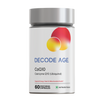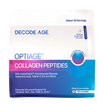Curious about the process of ageing and how to prevent it? Learn about the fascinating process of ageing and discover strategies to live longer in this informative article. Explore the latest research on reversing ageing and uncover practical tips for a healthier, happier life. Discover the secrets to reverse ageing and optimise your health today!
Ageing is a natural process and a part of life. But ageing is not supposed to be painful and accompanied by diseases. You can be 60 years old and still feel like a 20-year-old biologically. But do you find yourself wondering constantly about the mysteries of ageing and what measures can be taken to actually tackle it? Maybe after this article, you will find your answers and take measures accordingly to reverse ageing . So, grab your tea as we are here to spill the secrets of ageing. The industry is full of anti-ageing products, most of which work only at the surface level. The goal is healthy ageing and not anti-ageing, and hence it is best to target the key processes at the molecular level to embark on a healthy journey.
Over the past two decades, our understanding of the ageing process has only advanced, decoding the loopholes that were amassed over the previous two millennia. Owing to this progress, Longevity researchers are now able to develop products and therapies that have a strong potential to reverse ageing .
DNA is the basic blueprint of our lives, it has all the information that is needed for the sustenance of life, the way we are. As a consequence for a long time, it was believed that any changes in the DNA is the primary cause of ageing, however, as science and time progressed, researchers found more root causes of ageing.
Over the past two decades, our understanding of the ageing process has only advanced, decoding the loopholes that were amassed over the previous two millennia. Owing to this progress, Longevity researchers are now able to develop products and therapies that have a strong potential to slow down the ageing process.
DNA is the basic blueprint of our lives, it has all the information that is needed for the sustenance of life, the way we are. As a consequence for a long time, it was believed that DNA damage is the primary cause of ageing, however, as science and time progressed, researchers found more root causes of ageing.
DNA damage is just a minimal part of ageing
As mentioned earlier, DNA damage is not the only reason for ageing and several types of research has proven that. For instance, many animals that exhibit high rates of mutations do not tend to age faster or tend to live shorter. However, this does not imply that DNA damage plays no role in ageing. It simply means that it is just one of the many factors that contribute to the ageing process. In fact, ageing is caused by a multitude of other processes that have been extensively studied in recent years. So what are some of these other reasons why we age and eventually succumb to the consequences of ageing? Continue reading to find it out.
Reasons Why We Age?

1. Epigenetic dysregulation
Epigenetics refers to the study of how DNA interacts with various smaller molecules found within cells that can activate or deactivate genes. Unlike mutations, epigenetic changes occur "on" the DNA sequence, rather than "in" it. Epigenetic modifications can enhance or hinder the transmission of specific genes, essentially acting as an "on/off switch" for gene expression. Collectively, these modifications are referred to as the "epigenome." One example of an epigenetic phenomenon is DNA methylation, where the addition of methyl groups to DNA can suppress its transcription. Unfortunately, environmental and social factors can lead to the loss of critical epigenetic modifications, which can accelerate the ageing process.
The dysregulation of the epigenome may be one of the most significant contributors to the ageing process. The genes that should be inactive are being activated, such as cancer-promoting genes, and genes that should be active are being suppressed, such as genes that protect and repair our cells. Furthermore, the intricate machinery that regulates the winding of our DNA becomes disorganised over time, causing DNA and eventually entire cells to become unstable. Some experts contend that epigenetic dysregulation is the primary cause of ageing rather than DNA damage. Thankfully, there are substances such as alpha-ketoglutarate and NMN that can enhance the epigenome and potentially slow down the ageing process.
2. Accumulation of bad proteins
We all are aware of the fact that proteins are the building blocks of our body. Proteins are nothing but a product of our gene that is encoded by DNA. Each cell in our body contains millions of proteins which are crucial in the functioning of our body. These Proteins are continuously synthesised and degraded in a complex recycling process. But like several other cellular processes, this process is prone to errors. With age and other factors, some proteins resist degradation and start to accumulate. This accumulated protein starts acting as toxins also known as "protein toxicity" which is a consequence of "Loss of Proteostasis," and is a major contributor to the ageing process.
3. Mitochondrial dysfunction
While many are familiar with the widely recognized phrase, "mitochondria is the powerhouse of the cell," few are aware of its significant role in the ageing process. Beyond its production of ATP, the body's energy currency, mitochondria also functions as cellular stress sensors that can detect signs of cellular damage and impending cell death. Recent studies have illuminated the involvement of mitochondria in regulating inflammation in response to metabolic changes.
As we age, our mitochondria become increasingly damaged. Without properly functioning powerhouses, our cells begin to decline, leading to various symptoms of ageing. Fortunately, however, there are compounds such as NMN, alpha-ketoglutarate, Fisetin, and pterostilbene that can improve mitochondrial health and slow down the ageing process.
4. Telomere shortening and damage
Our genetic material is stored in chromosomes, which are condensed structures with protective cap-like structures called telomeres at their ends. Telomeres consist of repeated DNA sequences that help to maintain chromosome stability during cell division. During cell division, a portion of the telomere is lost, reducing the length of the chromosome by approximately 25 to 200 bases (A, C, G, or T) per division (citation needed). However, the rest of the chromosome is protected by the telomere, preventing the loss of crucial genetic information.
Without telomeres, important regions of DNA would be lost during cell division, potentially leading to the deletion of entire genes. As we age, the length of telomeres gradually shortens until they reach a "critical length," at which point the chromosome can no longer replicate. This triggers apoptosis, also known as programmed cell death. Telomerase is an enzyme that helps to maintain telomere length by adding back the lost repetitive sequences. However, the concentration of telomerase decreases as we age, contributing to the ageing process. This process of telomere shortening is known as telomere attrition and is considered one of the hallmarks of ageing.
5. Senescent cells
Senescence is a phenomenon that occurs when a cell pauses in its normal cell cycle as a result of injury. In healthy tissues, senescent cells are typically eliminated by the immune system. However, in older tissues, the immune system may become impaired and unable to remove these cells. As a result, senescent cells or called the “zombie” cells can accumulate and begin to release inflammatory signals that damage healthy tissues. This process can contribute to various age-related diseases and conditions.
The accumulation of senescent cells in various tissues can have detrimental effects on our bodies as we age. For instance, in the skin, the accumulation of senescent cells can contribute to the formation of wrinkles. In blood vessels, senescent cells can make them stiffer and increase the risk of atherosclerosis. Similarly, senescent cells in the brain can contribute to inflammation and ageing. Natural compounds like fisetin act as senolytic activators that can help eliminate these harmful cells, potentially improving overall health.
6. Genomic (DNA) instability
The genome refers to the complete set of genetic material in an individual's cell. Genomic instability, which is characterised by excessive damage to the DNA, can disrupt normal bodily functions and accelerate the ageing process. Although the human body has various mechanisms in place to repair damaged DNA, there is a threshold beyond which these repair mechanisms fail, leading to further genomic instability and ageing. Thus, maintaining the integrity of the genome is essential for healthy ageing.
7. A decline in stem cells
As we age, the amount of stem cells in our body decreases, and the remaining stem cells function less effectively, resulting in reduced tissue maintenance, repair, and replenishment. Stem cells are responsible for generating new cells that maintain tissue health, but the decline in stem cells is caused by various ageing mechanisms, including epigenetic dysregulation, mitochondrial dysfunction and protein accumulation which also affect stem cells. Additionally, senescent cells present throughout the body produce substances that impair the function of stem cells, and stem cells can also become senescent.
8. Altered intercellular communication and deregulated nutrient sensing
As we age, cellular communication becomes disrupted, leading to various negative effects on the body. Senescent cells, in particular, secrete harmful substances that damage healthy cells and contribute to inflammation throughout the body. Additionally, cells become less responsive to certain triggers, such as insulin and nutrients, resulting in insulin resistance and prolonged activation of ageing switches, like mTOR.
Other Reasons Why We Age As We Grow
As research into the ageing process continues, it is likely that additional causes of ageing will be uncovered. An individual’s diet, lifestyle and environmental stressors account for ageing. As one grows, these factors are increased and hence lead to ageing. One such factor is dysregulation of the transcriptome, which has been identified as a potential contributor to ageing. The transcriptome plays a role in regulating gene activity, similar to the way the epigenome operates. By finely tuning the activity of genes, the transcriptome can impact the ageing process.
Things We Can Do About the Ageing Process?
The road to combat and reverse ageing isn’t a difficult one, it lies in between and requires perseverance and resoluteness. A healthy diet, proper sleep along with regular exercise are a few of the many measures one can opt for. Longevity does not come overnight, it is an art of discipline and dedication. On the other hand, currently, researchers worldwide are actively developing powerful methods to impact each of the ageing mechanisms.
They are working towards epigenetically rejuvenating cells, reviving mitochondria, and mitigating protein accumulation and DNA damage. With increasing knowledge, compounds and ingredients are being developed to specifically work on the causes of ageing. For example, the intake of longevity supplements like NMN, Fisetin, Trans-Resveratrol and many more has proven beneficial in combating the signs of ageing. Slowing down and partially reversing ageing could significantly enhance the treatment of chronic diseases by treating the underlying cause - ageing itself.
Conclusion:
In conclusion, ageing is a natural process that cannot be stopped entirely, but it is possible to slow it down and live a healthier and longer life. The understanding of ageing has advanced significantly over the past two decades, leading to the development of products and therapies that have the potential to slow down the ageing process. While DNA damage is one of the factors that contribute to ageing, there are several other processes that have been extensively studied and found to be the root causes of ageing, including epigenetic dysregulation, accumulation of bad proteins, and mitochondrial dysfunction. By targeting these processes at a molecular level, we can embark on a healthy ageing journey. Practical tips such as regular exercise, a healthy diet, stress management and age reversing supplements are some of the simple measures one can take to achieve healthy ageing. Finally, the key to a long and healthy life is to maintain a positive attitude and take measures to keep oneself physically and mentally active.
Summary:
Ageing is an innate phenomenon, but it need not necessarily result in discomfort or illness. While DNA damage was once considered to be the main cause of ageing, recent research has uncovered various underlying factors, such as epigenetic dysregulation, the buildup of harmful proteins, and mitochondrial dysfunction. These factors, among others, have been extensively studied in the quest to understand ageing. Fortunately, longevity researchers have made significant progress in developing products and therapies that show promise in slowing down the ageing process. For instance, certain substances like alpha-ketoglutarate and NMN have been shown to enhance the epigenome, and therefore hold the potential in mitigating the effects of ageing.




















Leave a comment
All comments are moderated before being published.
This site is protected by hCaptcha and the hCaptcha Privacy Policy and Terms of Service apply.